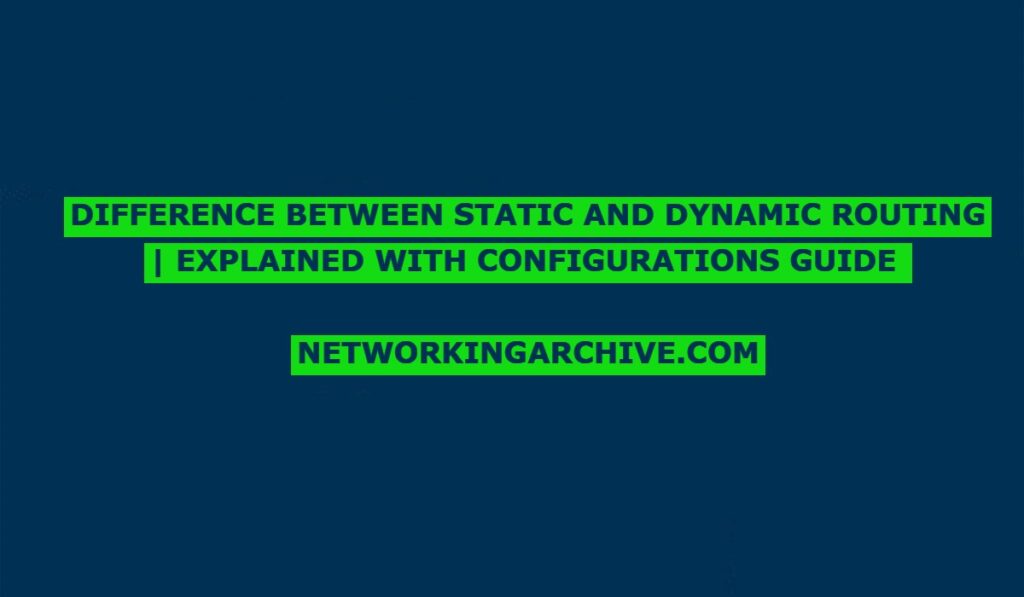Difference Between Static And Dynamic Routing: Definitions, Pros & Cons

What is Static Routing?
Static routing is maintained, updated, and created manually by the administrator. A static route must be configured on every router for full connectivity, making this process very inefficient and time-consuming to maintain. In this scenario, the router does not share updates with other routers, reducing the load on the CPU and RAM and saving bandwidth. However, static routing is not fault-tolerant; if any network goes down, manual intervention is required on all affected networks.
What is Dynamic Routing?
Dynamic routing is created, maintained, and updated by the routing protocol running on the router. This increases the load on the CPU, RAM, and bandwidth usage. Dynamic routing protocols include RIP (Routing Information Protocol), OSPF (Open Shortest Path First), and EIGRP (Enhanced Interior Gateway Protocol). In this scenario, if any network goes down, dynamic routing can choose the best alternate path automatically, eliminating the need for manual intervention. Difference Between Static And Dynamic Routing briefly explained in this guide
Advantages and Disadvantages of Static Routing
| Advantages | Disadvantages |
| Minimal CPU/Memory Load | Changes must be configured manually |
| Low Bandwidth Usage | No fault tolerance like Dynamic |
| Granular Control on each Router | Less efficient in larger network |
Advantages and Disadvantages of Dynamic Routing
| Advantages | Disadvantages |
| Easy to configure on larger network | Updated shared, consumed more bandwidth |
| Dynamically choose the best bath | More load on CPU and RAM |
| Do load balancing | Choosing of best routing path in control of routing protocol not in network engineer |
Also Learn : What is a Routing Table? How It Works Explained with Configuration Guide
Dynamic Routing Categories
There are two main categories of dynamic routing:
- Distance-Vector Protocols
- Link-State Protocols
Distance-vector routing protocols include RIP and IGRP. Link-state protocols include OSPF and IS-IS. However, EIGRP contains both distance-vector and link-state features and is called a hybrid protocol.
Distance-Vector Routing Protocols
Distance-vector routing protocols have several characteristics:
- Periodic updates of complete routing tables are sent to neighboring routers.
- These protocols suffer from slow convergence.
- They use distance as a metric to find the best path.
- The Bellman-Ford Algorithm is used to calculate the shortest path.
A distance-vector routing protocol sends updates to its directly connected interface and then to its neighbors. RIP updates every 30 seconds, and IGRP updates every 90 seconds. These updates are added to the neighbor’s routing table and sent to neighboring routers. Each neighbor trusts the updates and adds them to its routing table, a method known as routing by rumor.
This protocol also suffers from slow convergence because of these periodic updates. Another disadvantage is the complete trust in neighbors, making it susceptible to loops. RIP uses hop count for its distance metric, while IGRP uses bandwidth and delay.
Link-State Routing Protocols
Link-state routing protocols were developed to eliminate convergence and loop issues. This protocol maintains three routing tables:
- Neighbor Table: Contains the list of all connected neighbors and interfaces that send Hello packets.
- Topology Table: Contains the list of all links within the area and their status.
- Shortest-Path Table: The list of the shortest paths to each destination is referred to as the routing table.
In this protocol, all routers know all existing links in the routing table within the area and store this information in the topology table. Routers have the same topology table. If a link goes down, the concerned link status will send an advertisement to other routers, which then update their routing tables and adjust the best path again. This increases convergence and avoids loops. This protocol uses cost as it’s metric. The Dijkstra algorithm is used to calculate the shortest path first.
In this topic, we will discuss the static route configuration, understand the static route with best examples
Configuration of Static Routes
The basic syntax of static route is as follows
Router # ip route [destination address] [subnet mask] [next hope]
Let’s discuss the above examples with configuration
Router-A have the two connected networks 172.16.0.0/16 and the 172.17.0.0/16 and to add the static route pointing to the Route B 172.18.0.0/16
Router A # ip route 172.18.0.0 255.255.0.0 172.17.1.2
Same Router B have the 172.17.0.0/16 and 172.18.0.0/16 network and to add the static route pointing to the Router A 172.16.0.0/16
Router B # ip route 172.16.0.0 255.255.0.0 172.17.1.1
To remove the static route
Router B # no ip route 172.16.0.0 255.255.0.0 172.17.1.1
The exist interface can be used instead of next hope address
Router A # ip route 172.18.0.0 255.255.0.0 Fa0/1
What is Default Route?
If the specific route does not exist then router will destined all the traffic to that network. A default route or gateway of last resort send traffic to destination without any specific route. The default route known as both the zero’s network and subnet mask (0.0.0.0 0.0.0.0).
To configure the default route
Route # ip route 0.0.0.0 0.0.0.0 172.17.1.2




Pingback: What is RIP (Routing Information Protocol) in Networks? Explained
Pingback: What Is An FRL Unit? Importance Of Air Preparation In Pneumatic Systems
Pingback: Routing is a critical process in networking that determines – Purplegarnets.com
Pingback: This lack of flexibility makes static routing less suitable - Toastul